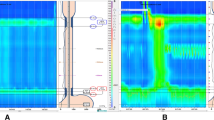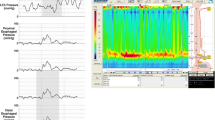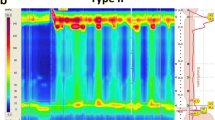Abstract
During nine years, 157 consecutive patients with achalasia have been dilated in our unit. First, the long-term effect of dilation on clinical status was evaluated. The probability of being in clinical remission eight years after first dilation was 51%. The pressure of the LES measured after dilation was highly predictive of the long-term clinical evolution. Second, a predictive model of the individual response to pneumatic dilation was developed and simplified. Therapy was effective in 80% of the patients, after one to four dilations. Younger age was the only factor significantly associated with ineffective therapy. Depending on the prognosis of the outcome calculated with the predictive model, patients were classified in groups of risk that showed a different rate of ineffective therapy. In the simplified model, age ≤20 years, male gender, esophageal body diameter ≤3 cm, esophageal body basal pressure >15 mm Hg, and pressure of the lower esophageal sphincter >30 mm Hg were predictors of a poor response to dilation. We conclude that pneumatic dilation is an effective therapy for achalasia. A predictive model was useful to classify the patients in groups with a different risk for ineffective dilation. A simplification of this model could be used to predict the response to dilation.
Similar content being viewed by others
References
Gelfand MD, Botoman VA: Esophageal motility disorders: A clinical overview. Am J Gastroenterol 82:181–187, 1987
Cohen S: Esophageal motility disorders and their response to calcium channel antagonists. The sphinx revisited. Gastroenterology 93:201–203, 1987
Feldman M: Southwestern internal medicine conference: Esophageal achalasia syndromes. Am J Med Sci 295:60–81, 1988
Sanderson DR, Ellis FH, Olsen AM: Achalasia of the esophagus: Results of therapy by dilatation 1950–1967. Chest 48:116–121, 1970
Arvanitakis C: Achalasia of the esophagus. A reappraisal of esophagomyotomy vs forceful pneumatic dilation. Am J Dig Dis 20:841–846, 1975
Okike N, Payne WS, Neufeld DM, Bernatz PE, Pairolero PC, Sanderson DR: Esophagomyotomy versus forceful dilation for achalasia of the esophagus. Results in 899 patients. Ann Thorac Surg 28:119–125, 1979
Sauer L, Pellegrini CA, Way LW: Treatment of achalasia. A current perspective. Arch Surg 124:929–932, 1989
Donahue PE, Schlesinger PK, Bombeck CT, Samelson S, Nihus LLM: Achalasia of the esophagus. Treatment controversies and the method of choice. Ann Surg 203:505–511, 1986
Csendes A, Braghetto I, Henriquez A, Cortes C: Late results of a prospective randomized study comparing forceful dilatation and oesophagomyotomy in patients with achalasia. Gut 30:299–304, 1989
Bennett JR: Treatment of achalasia: A review. J R Soc Med 73:649–654, 1980
Vantrappen G, Janssens J: To dilate or to operate? That is the question. Gut 24:1013–1019, 1983
Temple J: Achalasia: Dilatation or operation? J R Soc Med 79:695–696, 1986
Richter JE: Surgery or pneumatic dilatation for achalasia: A head-to-head comparison. Now are all the questions answered? Gastroenterology 97:1340–1341, 1989
Traube M: On drugs and dilators for achalasia. Dig Dis Sci 36:257–259, 1991
Vantrappen G, Hellemans J, Deloof W, Valembois P, Vandenbroucke J: Treatment of achalasia with pneumatic dilatations. Gut 12:268–275, 1971
Conover WJ: Practical Nonparametric Statistics. New York, John Wiley & Sons, 1980
Wasson JH, Sox HC, Neff RK, Goldman L: Clinical prediction rules. Applications and methodological standards. N Engl J Med 313:793–799, 1985
Yon J, Christensen J: An uncontrolled comparison of treatment for achalasia. Ann Surg 182:672–676, 1975
Vantrappen G, Hellemans J: Treatment of achalasia and related motor disorders. Gastroenterology 79:144–154, 1980
Lishman AH, Dellipiani AW: Management of achalasia of the cardia by forced pneumatic dilatation. Gut 23:541–544, 1982
Fellows IW, Ogilvie AL, Atkinson M: Pneumatic dilatation in achalasia. Gut 24:1020–1023, 1983
Dellipiani AW, Hewetson KA: Pneumatic dilatation in the management of achalasia. Experience of 45 cases. Q J Med 58:253–258, 1986
Agha FP, Lee HH: The esophagus after endoscopic pneumatic balloon dilatation for achalasia. AJR 146:25–29, 1986
Levine ML, Dorf BS, Moskowitz G, Bank S: Pneumatic dilatation in achalasia under endoscopic guidance: Correlation pre- and postdilatation by radionuclide scintiscan. Am J Gastroenterol 82:311–314, 1987
Gelfand MD, Korakek RA: An experience with polyethylene balloons for pneumatic dilatation in achalasia. Am J Gastroenterol 84:924–927, 1989
Barkin JS, Guelrud M, Reiner DK, Goldberg RI, Philips RS: Forceful balloon dilatation: An outpatient procedure for achalasia. Gastrointest Endosc 36:123–126, 1990
Barnett JL, Eisenman R, Nostrant TT, Elta GH: Witzel pneumatic dilation for achalasia: Safety and long-term efficacy. Gastrointest Endosc 36:482–485, 1990
Bourgeois N, Coffernils M, Buset M, Gelin M, Deltenre M, Panzer JM, Cremer M: Management of dysphagia in suspected esophageal motor disorders. Dig Dis Sci 36:268–273, 1991
Eckardt VF, Aignherr C, Bernhard G: Predictors of outcome in patients with achalasia treated by pneumatic dilation. Gastroenterology 103:1732–1738, 1992
Monges B, Grimaud JCH, Richeri JP, Botti G, Salducci J: Pneumatic dilatation in the treatment of achalasia. Int Surg 70:17–21, 1985
Ott DJ, Richter JE, Wu WC, Chen YM, Castell DO, Gelfand DW: Radiographic evaluation of esophagus immediately after pneumatic dilatation for achalasia. Dig Dis Sci 32:962–967, 1987
Robertson CS, Fellows IW, Mayberry JF, Atkinson M: Choice of therapy for achalasia in relation to age. Digestion 40:244–250, 1988
Mayberry JF, Mayell MJ: Epidemiological study of achalasia in children. Gut 29:90–93, 1988
Author information
Authors and Affiliations
Rights and permissions
About this article
Cite this article
Ponce, J., Garrigues, V., Pertejo, V. et al. Individual prediction of response to pneumatic dilation in patients with achalasia. Digest Dis Sci 41, 2135–2141 (1996). https://doi.org/10.1007/BF02071392
Received:
Revised:
Accepted:
Issue Date:
DOI: https://doi.org/10.1007/BF02071392




